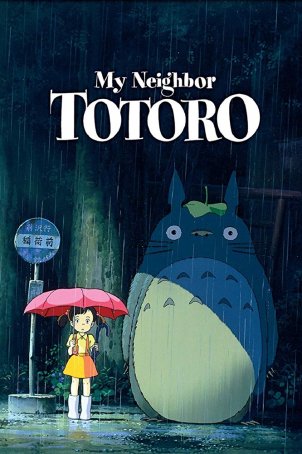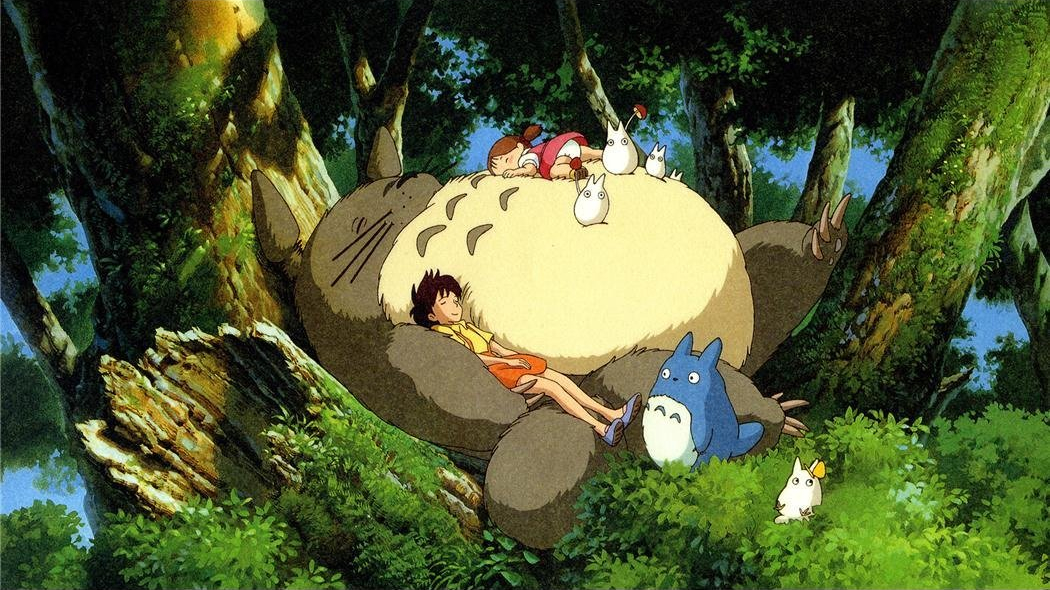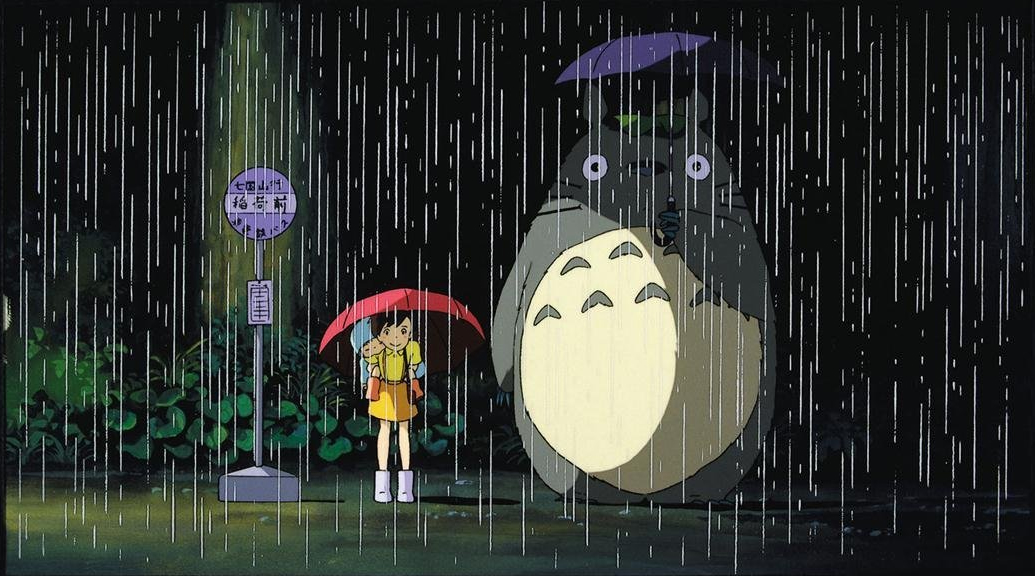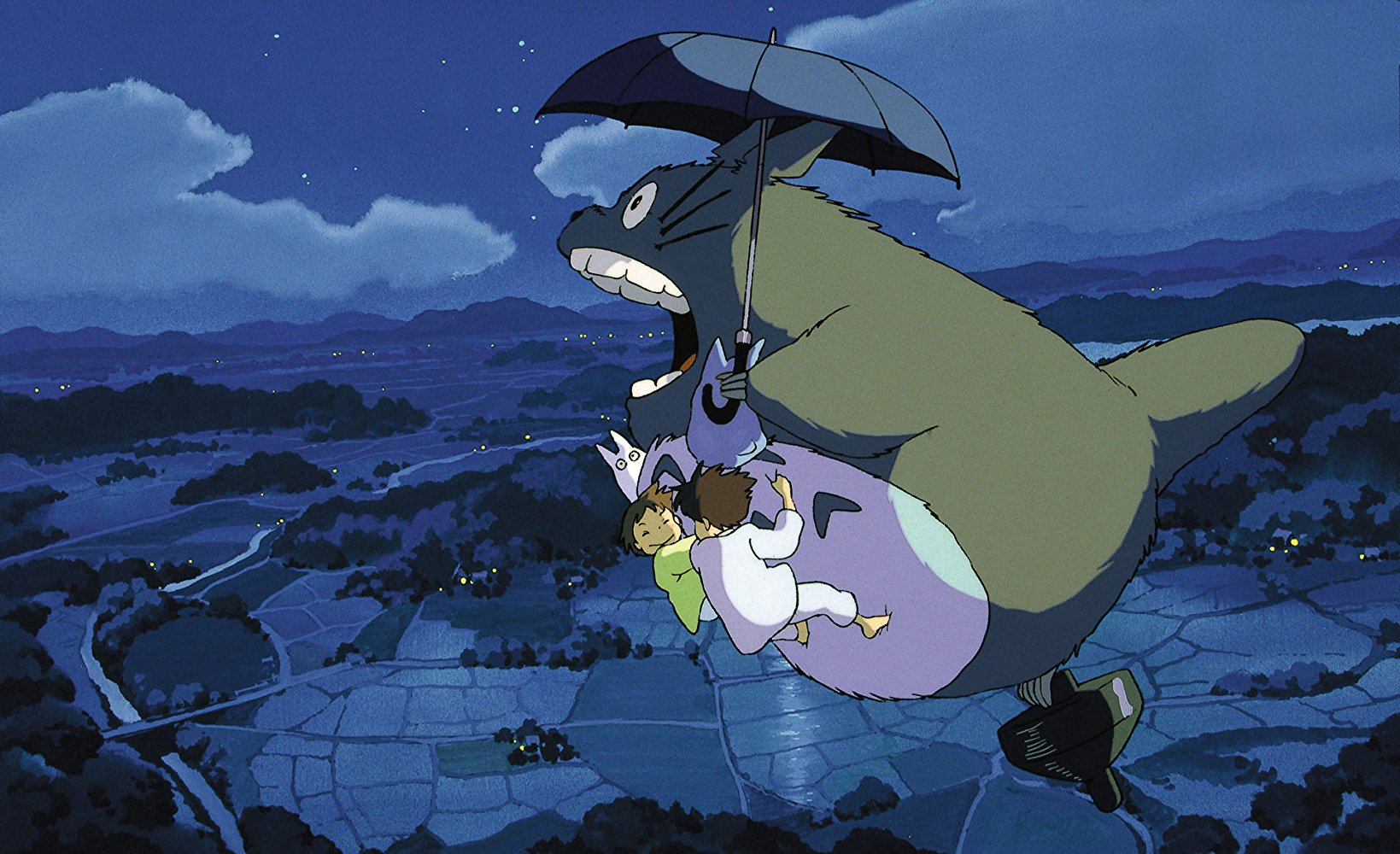My Neighbor Totoro (Japan, 1988)
June 29, 2018
What is it about Hayao Miyazaki’s My Neighbor Totoro that makes it such a pleasant, immersive experience? Unlike just about any other animated film (including the other titles in Miyazaki’s impressive oeuvre), My Neighbor Totoro contents itself with dramatizing the moment rather than trying to tell a traditional story. There are no villains. There’s no conflict. As presented from the perspective of two young girls, the movie sets out to provide (or should that be “remind”?) us with that magical, wondrous aspect of childhood where fantasy and reality intermingle and many of the cares of the outside world remain aloof.
Nothing in My Neighbor Totoro is meant to frighten or unnerve viewers. The film’s emotions – a little sadness and anxiety and a great deal of joy – come naturally through the circumstances. We aren’t forced to endure plot elements shoehorned into an otherwise leisurely story simply for the purpose of making it more “traditional” or “commercial.” A lot of films are marketed as “family friendly” but few espouse that label as fully as Totoro. There’s no question about the movie’s “appropriateness” regardless of the age of the viewer.
 Visuals have always been one of the great strengths of
Miyazaki’s films (due in part to the involvement of frequent collaborator, art
director Kazuo Oga) and the look of Totoro
– richly colored painted backgrounds and anime-inspired characters – is among
the most distinct of the legendary director’s efforts. CGI animation may give
us a greater sense of microdetail than Totoro
but it can’t match the sheer artistry of the production. Many of those working
in the field of animation quietly rue the demise of the hand-drawn variety, not
because there’s anything wrong with the computer-generated product but because
something organic and human gets lost. Even the most amazing of the great Pixar
films could be tagged with the label of “antiseptic.” No one would use that for
Totoro, which, especially if seen
under optimum conditions, astounds with its vibrancy.
Visuals have always been one of the great strengths of
Miyazaki’s films (due in part to the involvement of frequent collaborator, art
director Kazuo Oga) and the look of Totoro
– richly colored painted backgrounds and anime-inspired characters – is among
the most distinct of the legendary director’s efforts. CGI animation may give
us a greater sense of microdetail than Totoro
but it can’t match the sheer artistry of the production. Many of those working
in the field of animation quietly rue the demise of the hand-drawn variety, not
because there’s anything wrong with the computer-generated product but because
something organic and human gets lost. Even the most amazing of the great Pixar
films could be tagged with the label of “antiseptic.” No one would use that for
Totoro, which, especially if seen
under optimum conditions, astounds with its vibrancy.
There are a couple of different versions of the film out there for English-speaking viewers (as I write this in 2018). Both are available in the recently issued Blu-Ray set. I prefer the subtitled one – not only does it use the original voices and soundtrack (rather than a re-mix with well-known American actors) but the subtitles more accurately reflect the Japanese dialogue. The English-language iteration, which was recorded in the mid-2000s, stars sisters Dakota and Elle Fanning alongside Tim Daly and Lea Salonga. It’s not bad, especially if being shown to children too young to follow subtitles for the entire 90-minute feature, but the changes to the wording and occasionally shrill voice work will bother purists.
 The story transpires in 1958 Japan where a professor, Tatsuo
Kusakabe, and his daughters, Satsuki (the older one) and Mei (the younger),
move into an old house on the outskirts of a great forest. One of the first
things the girls notice about their new home is a massive camphor tree towering
above the rest of the woods. Later, they will learn that the tree is the home
of a giant, gentle forest creature called Totoro. Mei meets Totoro first but he
later reveals himself to Satsuki as well. The girls play with Totoro, ride on
his Catbus, and seek his help to visit their mother, who is recuperating from
an illness in a nearby hospital.
The story transpires in 1958 Japan where a professor, Tatsuo
Kusakabe, and his daughters, Satsuki (the older one) and Mei (the younger),
move into an old house on the outskirts of a great forest. One of the first
things the girls notice about their new home is a massive camphor tree towering
above the rest of the woods. Later, they will learn that the tree is the home
of a giant, gentle forest creature called Totoro. Mei meets Totoro first but he
later reveals himself to Satsuki as well. The girls play with Totoro, ride on
his Catbus, and seek his help to visit their mother, who is recuperating from
an illness in a nearby hospital.
As thin as the narrative may seem to be, Totoro has no problem filling its 90-minute running time. In fact, Miyazaki originally intended for the film to be an hour but it grew to 150% of that length during the planning stages as new elements were introduced. The movie feels neither rushed nor overlong. To borrow from “Goldilocks and the Three Bears”, it’s “just right.” The relaxed pacing allows for the natural development of the two girls and, more importantly, provides an opportunity to see things through their eyes. One can imagine the challenges faced by Professor Kusakabe, moving to a rickety old house (that obviously needs a lot of work) and acting as a single father to two girls while his wife is seriously ill. But that’s not the tale Totoro weaves. For the girls, it’s a time of laughter and exploration, of playing games and enjoying each other’s company. They see the beauty of the forest and, although they are concerned about their mother, the sadness doesn’t consume them. The house’s deficiencies are appealing quirks – from the rotting pillars holding up the roof to the dust bunnies and soot sprites inhabiting the closed-up rooms.
 Totoro, who looks a little like an oversized cross between a
bunny rabbit and a bear (with white teeth and a mighty roar), has become an
icon in Japan and is recognizable to many animation fans worldwide. The
creature’s popularity is such in its country of origin that it has been
compared to how Winnie the Pooh is regarded in the U.K. There have been toys
and stuffed animals. The image has been incorporated into the Studio Ghibli
logo. Totoro has made cameos in other Miyazaki films (including Pom Poko and Kiki’s Delivery Service) and a 13-minute sequel to My Neighbor Totoro, Mei and the Kittenbus.
[The short has never been released on home video or had regular showings in the
United States. It can be seen at the Ghibli Museum in Japan (or via a widely
circulated, pirated cam-copy).]
Totoro, who looks a little like an oversized cross between a
bunny rabbit and a bear (with white teeth and a mighty roar), has become an
icon in Japan and is recognizable to many animation fans worldwide. The
creature’s popularity is such in its country of origin that it has been
compared to how Winnie the Pooh is regarded in the U.K. There have been toys
and stuffed animals. The image has been incorporated into the Studio Ghibli
logo. Totoro has made cameos in other Miyazaki films (including Pom Poko and Kiki’s Delivery Service) and a 13-minute sequel to My Neighbor Totoro, Mei and the Kittenbus.
[The short has never been released on home video or had regular showings in the
United States. It can be seen at the Ghibli Museum in Japan (or via a widely
circulated, pirated cam-copy).]
During its original 1988 Japanese theatrical release, My Neighbor Totoro was paired on a double-bill with Isao Takahata’s Grave of the Fireflies. Although widely divergent in tone and intent, the films illustrate different strengths of Studio Ghibli’s approach to animation and both have become classics. One can see sense in matching the movies since Totoro’s ebullience provides a counterpoint to the powerful drama of Fireflies.
Totoro was Miyazaki’s fourth feature film and the second for Studio Ghibli, which he co-founded in 1985. Following Laputa: Castle in the Sky, Totoro helped to cement the director’s reputation as one of the world’s animation visionaries. Although Totoro wasn’t initially successful at the box office, it was a boon to merchandisers and its reputation has grown exponentially over the years. It remains one of Miyazaki’s most memorable endeavors and is among the handful of “must see” animated films that have been produced in the last 40 years.
My Neighbor Totoro (Japan, 1988)
Cast: Noriko Hidaka, Chika Sakamoto, Shigesato Itoi, Sumi Shimamoto, Tanie Kitabayashi
Home Release Date: 2018-06-29
Screenplay: Hayao Miyazaki
Cinematography: Hisao Shirai
Music: Jo Hisaishi
U.S. Distributor: Walt Disney Pictures
- (There are no more better movies of Noriko Hidaka)
- (There are no more worst movies of Noriko Hidaka)
- (There are no more better movies of Chika Sakamoto)
- (There are no more worst movies of Chika Sakamoto)
- (There are no more better movies of Shigesato Itoi)
- (There are no more worst movies of Shigesato Itoi)

Comments